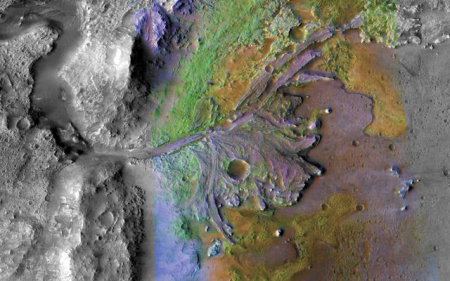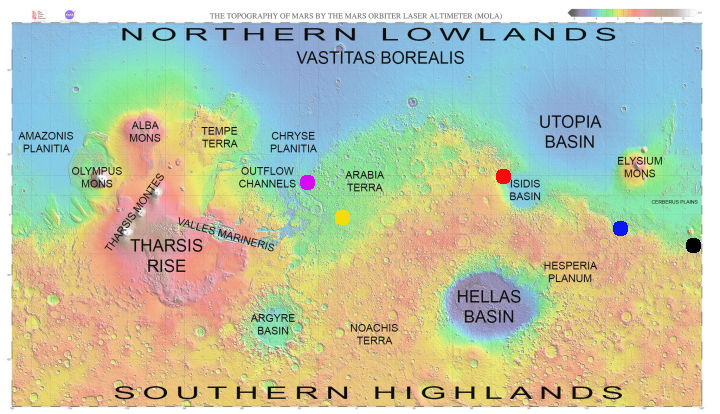NASA picks Mars 2020 landing site: Jezero Crater

NASA has picked Jezero Crater has the landing site for its as yet unnamed 2020 Mars rover.
Jezero Crater is located on the western edge of Isidis Planitia, a giant impact basin just north of the Martian equator. Western Isidis presents some of the oldest and most scientifically interesting landscapes Mars has to offer. Mission scientists believe the 28-mile-wide (45-kilometer) crater, once home to an ancient river delta, could have collected and preserved ancient organic molecules and other potential signs of microbial life from the water and sediments that flowed into the crater billions of years ago.
Jezero Crater’s ancient lake-delta system offers many promising sampling targets of at least five different kinds of rock, including clays and carbonates that have high potential to preserve signatures of past life. In addition, the material carried into the delta from a large watershed may contain a wide variety of minerals from inside and outside the crater.
The geologic diversity that makes Jezero so appealing to Mars 2020 scientists also makes it a challenge for the team’s entry, descent and landing (EDL) engineers. Along with the massive nearby river delta and small crater impacts, the site contains numerous boulders and rocks to the east, cliffs to the west, and depressions filled with aeolian bedforms (wind-derived ripples in sand that could trap a rover) in several locations.
The red dot on the map of Mars below shows this location. The blue dot is Gale Crater where Curiosity landed. The purple dot is the landing site for the European ExoMars rover. The yellow dot is where Opportunity has been roving, and the black dot is Spirit’s location.

You might notice a pattern. The scientists are focused on that transition zone between the high elevation southern terrain and the low flat northern plains, where an intermittent ocean might have once existed. Their reasoning is sound, as they are more likely going to get a wider variety of geology here, with evidence of water in this region where shoreline features are often found.
On Christmas Eve 1968 three Americans became the first humans to visit another world. What they did to celebrate was unexpected and profound, and will be remembered throughout all human history. Genesis: the Story of Apollo 8, Robert Zimmerman's classic history of humanity's first journey to another world, tells that story, and it is now available as both an ebook and an audiobook, both with a foreword by Valerie Anders and a new introduction by Robert Zimmerman.
The print edition can be purchased at Amazon or from any other book seller. If you want an autographed copy the price is $60 for the hardback and $45 for the paperback, plus $8 shipping for each. Go here for purchasing details. The ebook is available everywhere for $5.99 (before discount) at amazon, or direct from my ebook publisher, ebookit. If you buy it from ebookit you don't support the big tech companies and the author gets a bigger cut much sooner.
The audiobook is also available at all these vendors, and is also free with a 30-day trial membership to Audible.
"Not simply about one mission, [Genesis] is also the history of America's quest for the moon... Zimmerman has done a masterful job of tying disparate events together into a solid account of one of America's greatest human triumphs."--San Antonio Express-News

NASA has picked Jezero Crater has the landing site for its as yet unnamed 2020 Mars rover.
Jezero Crater is located on the western edge of Isidis Planitia, a giant impact basin just north of the Martian equator. Western Isidis presents some of the oldest and most scientifically interesting landscapes Mars has to offer. Mission scientists believe the 28-mile-wide (45-kilometer) crater, once home to an ancient river delta, could have collected and preserved ancient organic molecules and other potential signs of microbial life from the water and sediments that flowed into the crater billions of years ago.
Jezero Crater’s ancient lake-delta system offers many promising sampling targets of at least five different kinds of rock, including clays and carbonates that have high potential to preserve signatures of past life. In addition, the material carried into the delta from a large watershed may contain a wide variety of minerals from inside and outside the crater.
The geologic diversity that makes Jezero so appealing to Mars 2020 scientists also makes it a challenge for the team’s entry, descent and landing (EDL) engineers. Along with the massive nearby river delta and small crater impacts, the site contains numerous boulders and rocks to the east, cliffs to the west, and depressions filled with aeolian bedforms (wind-derived ripples in sand that could trap a rover) in several locations.
The red dot on the map of Mars below shows this location. The blue dot is Gale Crater where Curiosity landed. The purple dot is the landing site for the European ExoMars rover. The yellow dot is where Opportunity has been roving, and the black dot is Spirit’s location.

You might notice a pattern. The scientists are focused on that transition zone between the high elevation southern terrain and the low flat northern plains, where an intermittent ocean might have once existed. Their reasoning is sound, as they are more likely going to get a wider variety of geology here, with evidence of water in this region where shoreline features are often found.
On Christmas Eve 1968 three Americans became the first humans to visit another world. What they did to celebrate was unexpected and profound, and will be remembered throughout all human history. Genesis: the Story of Apollo 8, Robert Zimmerman's classic history of humanity's first journey to another world, tells that story, and it is now available as both an ebook and an audiobook, both with a foreword by Valerie Anders and a new introduction by Robert Zimmerman.
The print edition can be purchased at Amazon or from any other book seller. If you want an autographed copy the price is $60 for the hardback and $45 for the paperback, plus $8 shipping for each. Go here for purchasing details. The ebook is available everywhere for $5.99 (before discount) at amazon, or direct from my ebook publisher, ebookit. If you buy it from ebookit you don't support the big tech companies and the author gets a bigger cut much sooner.
The audiobook is also available at all these vendors, and is also free with a 30-day trial membership to Audible.
"Not simply about one mission, [Genesis] is also the history of America's quest for the moon... Zimmerman has done a masterful job of tying disparate events together into a solid account of one of America's greatest human triumphs."--San Antonio Express-News


I do hope everything goes well with this missions landing…. But color me sceptical, who here was confident of Curiositys landing? With the rocket powered landing platform and sky crane lowering the rover into place….
I was awake at 4am ( ISH… It was middle of the night here in Sweden when it touched down… And shared a glass of bubbly with my mother , another space nut, early morning on a work day…
I doubted the capability then, NASA proved me wrong… The tech worked flawlessly…
But adding a whole new level of automity into the mix with this hazard avoidence system… It leaves me scratching my chin….
I love the drone fitted aboard ( no mention on in months… I hope it’s still included..), but messing with a “flight proven” landing system on a mission to one of the hardest bodies in the solar system to soft land upon… I just hope they have covered all bases….
Good luck NASA! ( And great choice of landing site!)
Lee S.
Lee–
..that’s worth a repeat:
7 Minutes of Terror: Curiosity Rover’s Landing
https://youtu.be/h2I8AoB1xgU
5:06
Lee S asked: “But color me sceptical, who here was confident of Curiositys landing?”
As wayne nearly stated, even JPL was more terrified of than confident in their chosen method for landing Curiosity.
Edward–
That’s one of the best animation shorts I’ve ever seen from NASA. It’s a perfect example of “breathtaking PR.” The Story is so inherently Fantastic, they don’t even have to lie about it!
I can’t believe it worked as well as it did!
wayne,
I saw that video back before Curiosity landed, and my first thought was “you have got to be kidding.” And yet final touchdown worked as planned. NASA’s JPL does not lack for imagination and innovation. It is still NASA at its best.
Back in the 1960s, NASA’s films looked like they were made by government amateur filmmakers. These days, JPL and Goddard are putting out some very nice videos that look like they’re made by professionals.